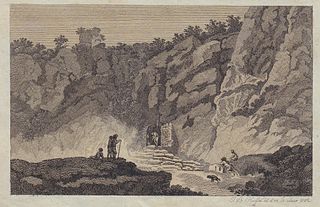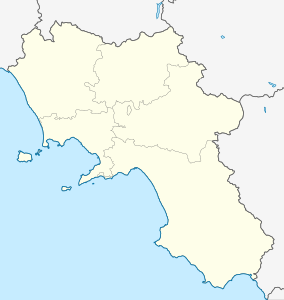Dog grotto
| Dog grotto
|
||
|---|---|---|
|
Dog grotto near Naples (copper engraving by Johann Baptist Hoessel from 1805) |
||
| Location: | Campania , Italy | |
|
Geographic location: |
40 ° 50 ′ 0 ″ N , 14 ° 10 ′ 0 ″ E | |
|
|
||
| Type: | Lava cave | |
| Overall length: | 9 m | |
The Hundsgrotte or Dog Cave , in Italian Grotta del Cane , is a lava cave belonging to the group of Mofetten in the Phlegraean Fields , west of Naples . The cave is about 8 to 9 meters long and at the entrance 2 meters high and 1.1 meters wide. The floor slopes backwards so that the entrance is the highest point of the cave.
Due to volcanic activity, carbon dioxide escapes from the cave floor , which, due to the higher density, collects on the floor and cannot flow away because of the cave's incline. The concentrations of the air at the cave floor are about 67.1% to 73.6% carbon dioxide and 26.4% to 21.1% nitrogen . These high levels of carbon dioxide are suffocating, which means that smaller animals such as dogs that are near the ground can suffocate. The name of the cave is derived from this phenomenon. After World War II, the grotto was walled up and is therefore no longer accessible.
literature
- Alfred Taylor: About the dog grotto in Neapolitan . In: Ludwig Friedrich von Froriep (ed.): Notes from the field of natural science and medicine . tape XXXVI , 774 of February 1833. Lossius, Erfurth 1833 ( limited preview in Google book search [accessed December 12, 2011]).
- Ester Majo: I fenomeni vulcanici della grotta del Cane (Campi Flegrei) in rapporto alle variazioni atmosferiche. In: Bulletin Volcanologique. 4, 1, 1927, pp. 84-92, doi: 10.1007 / BF02719519 .
Web links
- http://www.napoliunderground.org/index.php/it/napoli/126-le-antiche-terme-di-agnano-e-la-grotta-del-cane - sectional drawings and photos
Individual evidence
- ↑ Catherine-Joseph Ferdinand and Girard de Propiac: New 114 wonders of the world, natural secrets and extraordinary phenomena on earth, stone, animal and plant kingdoms in the sea, in the air and on the moon . Karl Brüggemann, Halberstadt 1831, p. 58 ( limited preview in Google Book Search [accessed February 2, 2017]).
- ↑ Christa-Vera Grewe: Investigation of the scientific fragments of the Stoic philosopher Poseidonios and their significance for his natural philosophy. Approved dissertation at the University of Hanover, Hanover 2005, p. 165, online (accessed on August 17, 2018).

